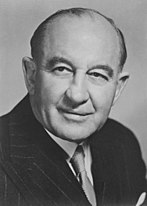New South Wales state election, 1941
|
|
||||||||||||||||||||||||||||||||||
|---|---|---|---|---|---|---|---|---|---|---|---|---|---|---|---|---|---|---|---|---|---|---|---|---|---|---|---|---|---|---|---|---|---|---|
|
||||||||||||||||||||||||||||||||||
|
All 90 seats in the New South Wales Legislative Assembly 46 Assembly seats were needed for a majority |
||||||||||||||||||||||||||||||||||
|
||||||||||||||||||||||||||||||||||

Legislative Assembly after the election
|
||||||||||||||||||||||||||||||||||
|
||||||||||||||||||||||||||||||||||
Alexander Mair
UAP/Country coalition
The 1941 New South Wales state election was held on 10 May 1941. This election was for all of the 90 seats in the 33rd New South Wales Legislative Assembly and was conducted in single-member constituencies with compulsory preferential voting.
The replacement of Jack Lang by William McKell as leader of the Labor Party in 1939 reunited and rejuvenated the party. A small number of Labor party members continued to support the far left wing State Labor Party (Hughes-Evans) but this had minimal impact on the election results. The party moved away from Lang's populist, inflationary policies, which were seen as extremist by many voters in the middle ground of the political spectrum. McKell also improved the party's standing in rural electorates by personally selecting locally well-known candidates.
By contrast, the internal party divisions and lack of policy direction affecting the United Australia Party (UAP) had resulted in Alexander Mair replacing Bertram Stevens as leader of the UAP and Premier in August 1939. The problems continued in the period prior to the election and throughout the course of the new parliament. These divisions were reflected federally in the forced resignation of Robert Menzies as the Prime Minister in August 1941, and the UAP disintegrated at a state level in 1943. The remnants of the UAP combined with the newly formed Commonwealth Party to form the Democratic Party in that year. Mair remained Leader of the Opposition until 10 February 1944 when he was replaced by Reginald Weaver.
...
Wikipedia


